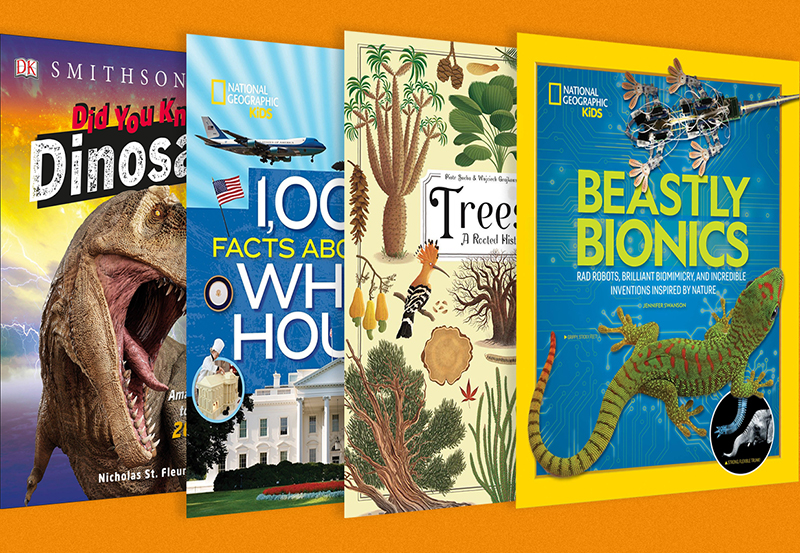Long on Kid Appeal, Browsable Nonfiction Continues to Trend
Lavishly illustrated, with appealing design, browsable nonfiction has revolutionized children’s books by giving young fact lovers a fresh, engaging way to access information. And more titles are on the horizon.

I first heard the term “browsable nonfiction” used by Jennifer Emmett, senior vice president of National Geographic for Kids in 2012 at a Society of Children’s Book Writers and Illustrators (SCBWI) writing retreat in Silver Bay, NY. It’s the perfect moniker for a popular category of children’s books inspired by Dorling Kindersley’s groundbreaking Eyewitness Book series.
When these lavishly photo-illustrated books entered the U.S. marketplace in 1991, they revolutionized children’s nonfiction by giving young fact lovers a fresh, engaging way to access information. Both then and now, the eye-catching design and short blocks of clear, straightforward expository text delight “info-kids” who crave knowledge about the world and how it works and their place in it.
Read: Understanding—and Teaching—the Five Kinds of Nonfiction
Here’s what some young readers have to say about browsable books:
- “You can open to any page and find a cool fact, and I like reading cool facts.” —Lily, second grader
- “You have a lot of choices about how you read. It’s like the potluck dinners at my church.” —Matthew, fourth grader
- “I like the design. I prefer to flip through the pages to find exactly what I’m looking for rather than having to read through a whole book.” —Keith, fifth grader
The ability to dip in and out of these books instead of reading from cover to cover is a key characteristic of browsable nonfiction, but—initially—it was this very aspect of the category that worried adults.
“When Eyewitness Books first came out, some educators thought the format would interfere with students’ ability to develop critical reading skills,” says Michele Nokleby, school librarian, Hawthorne Elementary School, Missoula, MT. “They wondered: Would these books impact reading stamina? Would they affect students’ attention spans? As a result, teachers were hesitant to use them in the classroom.”
Luckily, that attitude has changed. As is increasingly true with graphic novels, educators now recognize that browsable nonfiction is a gateway to literacy for many children. And according to Marlene Correia, associate professor of elementary and early childhood education, Bridgewater (MA) State University, these books can also “help students who prefer fiction develop the skills necessary to navigate the more complex expository texts they’ll encounter in high school and college, and in their future careers.”
In response to the heightened interest in browsable nonfiction from kids as well as educators, media companies like National Geographic, Time for Kids, Guinness World Records, and the Discovery Channel are publishing dozens of these fact-tastic books every year. Examples include 1,000 Facts About the White House by Sarah Wassner Flynn, Beastly Bionics: Rad Robots, Brilliant Biomimicry, and Incredible Inventions Inspired by Nature by Jennifer Swanson, Did You Know? Dinosaurs by Nicholas St. Fleur, Sharkopedia: The Complete Guide to Everything Shark by Discovery Channel, and North America: A Fold-Out Graphic History by Sarah Albee.
Read: "5 Tips for Starting a Nonfiction Book Club for Kids"
Unfortunately, very few browsable books are created by BIPOC or people from other traditionally marginalized communities. Hopefully, this will change as trade publishers, who are committed—finally—to making equity and inclusion a priority in their publishing programs, begin offering a broader array of nonfiction. Young readers deserve access to titles by a diverse range of creators on every info-licious topic under the sun.
“Macmillian’s recent announcement of the new imprint Neon Squid Books, which will be headed up by three DK Publishing veterans, bodes well for the future of browsable nonfiction,” says Emma D. Dryden, editorial and publishing consultant at drydenbks LLC. Another good sign is the attention these books are now receiving from reviewers and awards committees.
In 2019, the browsable title Trees: A Rooted History, created byPiotr Socha and Wojciech Grajkowski received a starred review from Publisher’s Weekly. In 2020, How We Got to the Moon: The People, Technology, and Daring Feats of Science Behind Humanity’s Greatest Adventure, written and illustrated by John Rocco, received four starred reviews. It was also a Sibert Honor, a YALSA Excellence in Young Adult Nonfiction finalist, an SCBWI Golden Kite finalist, and a National Book Award nominee.
There’s no doubt we’re in a golden age of nonfiction. As the children’s literature community realizes just how many children love nonfiction and makes a concerted effort to honor and value a wide range of fact-based books brought to life by a diverse array of creators, it seems likely that the market for browsable books will continue to grow and evolve in new and exciting ways.
Melissa Stewart has written more than 180 science books for children. She co-wrote 5 Kinds of Nonfiction: Enriching Reading and Writing Instruction with Children’s Books and edited the anthology Nonfiction Writers Dig Deep: 50 Award-winning Authors Share the Secret of Engaging Writing.
Add Comment :-
The job outlook in 2030: Librarians will be in demand
The job outlook in 2030: Librarians will be in demand
ALREADY A SUBSCRIBER? LOG IN
We are currently offering this content for free. Sign up now to activate your personal profile, where you can save articles for future viewing





